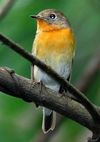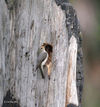Genus Ficedula
Collared Flycatcher - This is a 12-13.5 cm long bird. The breeding male is mainly black above and white below, with a white collar, large white wing patch, black tail and a large white forehead patch. It has a pale rump. The bill is black and has the broad but pointed shape typical of aerial insectivores. As well as taking insects in flight, this species hunts caterpillars amongst the oak foliage, and will take berries.
Little Slaty Flycatcher - Its natural habitat is subtropical or tropical moist lowland forests. It is threatened by habitat loss.
Lompobattang Flycatcher - Its natural habitat is subtropical or tropical moist montanes. It is threatened by habitat loss.
Cinnamon-chested Flycatcher - Its natural habitat is subtropical or tropical moist montanes.
Cryptic Flycatcher - Its natural habitat is subtropical or tropical moist lowland forests.
Ficedula disposita - Its natural habitats are subtropical or tropical moist lowland forests and subtropical or tropical moist montanes. It is threatened by habitat loss.
Rufous-chested Flycatcher - The Rufous-chested Flycatcher is a species of bird in the Muscicapidae family. It is found in Brunei, Indonesia, Malaysia, and Thailand. Its natural habitats are subtropical or tropical moist lowland forests and subtropical or tropical moist montanes. It is threatened by habitat loss.
Sumba Flycatcher - Its natural habitat is subtropical or tropical moist lowland forests.
Damar Flycatcher - Its natural habitat is subtropical or tropical moist lowland forests. It is affected by habitat loss. Having turned out to be more common than previously believed, it is downlisted from Vulnerable to Near Threatened in the 2007 IUCN Red List.
Slaty-backed Flycatcher - It is found in Bhutan, Cambodia, China, India, Laos, Myanmar, Nepal, and Thailand. Its natural habitats are subtropical or tropical moist lowland forests and subtropical or tropical moist montane forests.
Snowy-browed Flycatcher - It is found in Bangladesh, Bhutan, Cambodia, China, India, Indonesia, Laos, Malaysia, Myanmar, Nepal, the Philippines, Taiwan, Thailand, and Vietnam. Its natural habitats are subtropical or tropical moist lowland forests and subtropical or tropical moist montane forests.
European Pied Flycatcher - This is a 12-13.5 cm long bird. The breeding male is mainly black above and white below, with a large white wing patch, white tail sides and a small forehead patch. The Iberian subspecies iberiae has a larger forehead patch and a pale rump. Non-breeding males, females and juveniles have the black replaced by a pale brown, and may be very difficult to distinguish from other Ficedula flycatchers, particularly the Collared Flycatcher, with which this species hybridizes to a limited extent .
White-gorgeted Flycatcher - It is found in Bangladesh, Bhutan, China, India, Laos, Myanmar, Nepal, Thailand, and Vietnam. Its natural habitat is subtropical or tropical moist montane forests.
Mugimaki Flycatcher - It is 13 to 13.5 centimetres long. It has a rattling call and often flicks its wings and tail. The adult male has blackish upperparts with a short white supercilium behind the eye, a white wing-patch, white edges to the tertials and white at the base of the outer tail-feathers. The breast and throat are orange-red while the belly and undertail-coverts are white. The female is grey-brown above with a pale orange-brown breast and throat. She lacks white in the tail, has one or two pale wingbars rather than a white wing-patch and has a supercilium that is either faint or absent entirely. Young males are similar to the female but have a brighter orange breast, white in the tail and a more obvious supercilium.
Narcissus flycatcher - Narcissus Flycatcher males are very distinctive in full breeding plumage, having a black crown and mantle, a bright orange throat with paler chest and underparts, an orange-yellow eyebrow, black wings with a white wing patch, an orange-yellow rump, and a black tail. Non-breeding males have varying levels of yellow. Females are completely dissimilar, with generally buff-brown coloration, with rusty-colored wings, and a two-toned eyering.
Black-and-orange Flycatcher - The Black-and-orange Flycatcher is a species of flycatcher endemic to the central and southern Western Ghats, the Nilgiris and Palni hill ranges in southern India. It is unique among the Ficedula flycatchers in having rufous coloration on its back and prior to molecular studies was suggested to be related to the chats and thrushes.
Red-breasted Flycatcher - The Asian race Ficedula parva albicilla has the red throat surrounded by grey and a different song. It is sometimes separated as the Taiga Flycatcher, or Red-throated Flycatcher, Ficedula albicilla .
Palawan Flycatcher - Its natural habitat is subtropical or tropical moist lowland forests. It is threatened by habitat loss.
Rufous-throated Flycatcher - Its natural habitat is subtropical or tropical moist lowland forests. It is threatened by habitat loss.
Sapphire Flycatcher - It is found in Bangladesh, Bhutan, China, India, Laos, Myanmar, Nepal, Thailand, and Vietnam. Its natural habitat is subtropical or tropical moist montane forests.
Semicollared Flycatcher - This is a 12-13.5 cm long bird, intermediate in appearance between Collared Flycatcher and European Pied Flycatcher. It has often been classed as a subspecies of Collared Flycatcher.
Rufous-browed Flycatcher - The Rufous-browed Flycatcher is a species of bird in the Muscicapidae family. It is found in Indonesia, Laos, Malaysia, Myanmar, Thailand, and Vietnam. Its natural habitat is subtropical or tropical moist montanes.
Orange-gorgetted Flycatcher - It is found in Bangladesh, Bhutan, China, Hong Kong, India, Laos, Myanmar, Nepal, Thailand, and Vietnam. Its natural habitat is subtropical or tropical moist montane forests.
Kashmir Flycatcher - This is an insectivorous species which breeds in the north-west Himalayas in the Kashmir area of Pakistan and India. It is migratory and winters in the hills of central Sri Lanka and the Western Ghats of India.
Ultramarine Flycatcher - Summer: Common breeding visitor to the western Himalayas, from Kohat in North-West Frontier Province, Pakistan east through Kashmir to Uttaranchal , and intergrading with in Nepal with the eastern race aestigma which continues in the eastern Himalayas through Bhutan to Arunachal Pradesh to Tibet. Breeding between 2000-2700m, occasionally as low as 1800 and as high as 3200m. Also in the lower hills of Meghalaya and Nagaland, Khasi and Cachar hills, sometimes considered a third race; winter movements of this population is not known . Habitat: Open, mixed forests of oak, rhododendron, pine, fir, etc., occasionally orchards.
Black-banded Flycatcher - The Black-banded Flycatcher is an uncommon spepies that is difficult to see and very little is known about its biology. The natural habitat of the species is lowland monsoon forests and hill forests up to 1200 m. Nothing is known about its breeding behaviour, the only observations of this are adults feeding recently fledged chicks in December. It feeds singly or in pairs on invertebrates, taking its prey mostly by gleaning with a few sallying flights to snatch ariel prey. The species is currently listed as near threatened. It is threatened by habitat loss.
Slaty-blue Flycatcher - It is found in Bangladesh, Bhutan, China, India, Laos, Myanmar, Nepal, Pakistan, Thailand, and Vietnam. Its natural habitat is subtropical or tropical moist montane forests.
Little Pied Flycatcher - Its natural habitats are subtropical or tropical moist lowland forests and subtropical or tropical moist montane forests.
Yellow-rumped Flycatcher - The Yellow-rumped Flycatcher, Korean Flycatcher or Tricolor Flycatcher is a species of flycatcher found in Asia. A distinctive species with almost no look-alike other than the Narcissus Flycatcher. It breeds in eastern Asia including parts of Mongolia, Transbaikal, southern China, Korea and western Japan. They winter in parts of the Malay Peninsula and South Asia.







